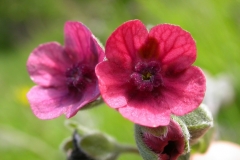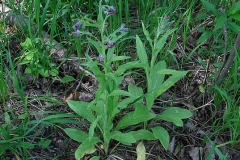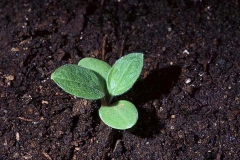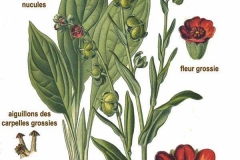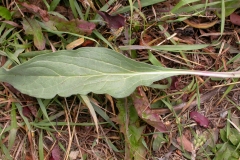| Hounds Tongue Quick Facts | |
|---|---|
| Name: | Hounds Tongue |
| Scientific Name: | Cynoglossum officinale |
| Shapes | 1/3 inch long |
| Name | Hounds Tongue |
|---|---|
| Scientific Name | Cynoglossum officinale |
| Common/English Name | Gypsy Flower, Dog’s Tongue, Hounds-tongue, Houndstongue, Hound’s Tongue, Gypsyflower, Gypsy Flower, Rats and Mice, Houndstooth, Dog-bur, Sheep lice, Woolmat |
| Name in Other Languages | Swedish: koirankieli, Norskt björnbär, Nutkahallon, Sötbjörnbär, Taggbjörnbär, Hundtunga; Finnish: koirankieli, Poimuvatukka; Danish: Almindelig Brombær, Læge-hundetunge |
| Plant Growth Habit | Annual or biennial |
| Plant Size | 30–70 cm (12–30 in.) high |
| Leaf | Greyish, lanceolate to oblong, 1 to 12 inches long, 1 to 3 inches wide |
| Medicinal parts | The leaves and root |
| Flowering Season | May and September |
| Flower | Reddish-purple funnel, 5-10 mm wide |
| Fruit shape & size | 1/3 inch long |
| Seed | Ovoid |
Uses
- The Indian’s knowledge of Hound’s-tongue was to cook the root for relief in colic, and as a poultice for scalds and burns.
- It is chiefly valuable for coughs, catarrh, bleeding from the lungs and other disorders of the respiratory apparatus, the action of the root being cooling, drying and binding.
- It is very soothing to the digestive organs in diarrhoea, dysentery and relief of piles.
- It is used for dysentery and diarrhea.
- It is also helpful for coughs, indigestion, catarrh, chronic bronchitis, colic, neuralgia, neuritis, colds and lung problems.
- Use it externally for burns, scratches, bruises, snakebites, insect bites, tumors, piles, abrasions, scrofula, goiters, boils and difficult wounds.
- Leaves and roots act as antispasmodic, antihaemorrhoidal, analgesic, digestive, astringent, slightly narcotic and emollient.
- The plants are helpful to relieve pain.
- Use it externally as a poultice on wounds, piles, bites, minor injuries and ulcers.
- It is effective for insomnia.
- Tea prepared from leaves and roots are used for colds, coughs, hemorrhoids, irritated membranes, dysentery and diarrhea.
- Use the root decoction or as pills for cough, shortness of breath and colds in head.
- Use the leaves boiled in wine as a cure for dysentery.
Externally
According to Herbalists of long experience, bruised Hound’s-tongue leaves applied to the lesion of a bite from a mad dog is the only medication needed. They also state that loss of hair from high fevers is controlled by bruising the leaves and making a salve with swine’s grease and massaging over the scalp.
The leaves and root are both applied with great benefit as a poultice to old ulcers, scrofulous tumours, burns, goitres and recent bruises and abrasions.
Russian Experience
If the Russian name, Sobachyi Yazik, were translated it would be the same as our common name, Dog’s tongue, but in literature it is used as Chernyi Koren—Black Root. Old Folk Medicine found many uses for Hound’s-tongue: to reduce pain, swelling of boils, cramps, coughs, tuberculosis and stomach aches. The leaves were collected when in flower, May to June; roots in late summer and early autumn. Recent literature usually warns against unexperienced use as it has a toxic effect if improperly administered.
Externally
It is used as a poultice for boils, wounds, ulcers and the bite of snakes or mad dogs. The powder mixed with grease, oil or lard as an ointment for rheumatic pains, and as Nastoika (with vodka) for wounds.
Insecticide
It is not unusual to find organic material poisonous to troublesome creatures such as insects and rodents. It has been proven that these creatures cannot stand the smell of Dog’s-tongue, and will leave the premises as soon as the aroma reaches them. It is said they will abandon ship and jump into the sea if there is a trace of this used as an insecticide.
References:
https://www.itis.gov/servlet/SingleRpt/SingleRpt?search_topic=TSN&search_value=31890#null
https://botanical.com/botanical/mgmh/h/houndt40.html
https://en.wikipedia.org/wiki/Cynoglossum_officinale
http://medicinalherbinfo.org/000Herbs2016/1herbs/hounds-tongue/
http://montana.plant-life.org/cgi-bin/species03.cgi?Boraginaceae_Cynoglossumofficinale



